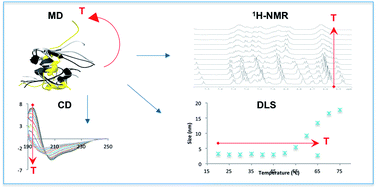Biophysical characterization of a protein for structure comparison: methods for identifying insulin structural changes†
Abstract
Although protein structure has been studied for many decades it remains the case that we cannot state with confidence whether two samples have the same molecular structure, particularly in solution. The increasing number of biosimilar biopharmaceutical drugs that are being tested means this is not an academic exercise. In this work we consider how four well-established techniques: dynamic light scattering (DLS), circular dichroism (CD), nuclear magnetic resonance spectroscopy (NMR), and molecular modelling can be combined to provide information about the supposedly well-understood protein insulin. A goal of this work was to establish a systematic means of detecting differences between insulin samples as a function of pH, temperature, and the presence or absence of zinc, all of which are known to change the oligomerisation state and to affect molecular structure. We used the recently developed Secondary Structure Neural Network (SSNN) circular dichroism algorithm to facilitate analysis of the CD spectra.



 Please wait while we load your content...
Please wait while we load your content...